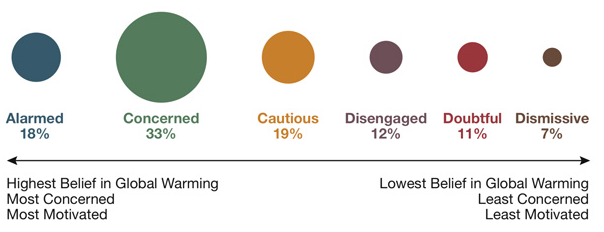
Departing a bit from the usual posts, I thought the report I talk about here is so important that it merits special treatment. Given the clamor that always accompanies any “political” conversation about climate change, carefully gathered and analyzed data on public attitudes is invaluable. Much of what goes for survey data is suspect and presented by some group way to one side of the issue or the other.
But now we can turn to an extremely carefully executed study of attitudes done by the Yale Project on Climate Change and the George Mason University Center for Climate Change Communication. The title is *[Global Warming’s Six Americas 2009: An Audience Segmentation Analysis](http://environment.yale.edu/uploads/6Americas2009.pdf)*. Here’s the Executive Summary.
>
> One of the first rules of effective communication is to “know thy audience.” Climate change public communication and engagement efforts must start with the fundamental recognition that people are different and have different psychological, cultural, and political reasons for acting – or not acting – to reduce greenhouse gas emissions. This report identifies Global Warming’s Six Americas: six unique audiences within the American public that each responds to the issue in their own distinct way.
>
> The six audiences were identified using a large nationally representative survey of American adults conducted in the fall of 2008. The survey questionnaire included extensive, in-depth measures of the public’s climate change beliefs, attitudes, risk perceptions, motivations, values, policy preferences, behaviors, and underlying barriers to action. The Six Americas are distinguishable on all these dimensions, and display very different levels of engagement with the issue. They also vary in size – ranging from as small as 7 percent to as large as 33 percent of the adult population.
>
> The Alarmed (18%) are fully convinced of the reality and seriousness of climate change and are already taking individual, consumer, and political action to address it. The Concerned (33%) – the largest of the six Americas – are also convinced that global warming is happening and a serious problem, but have not yet engaged the issue personally. Three other Americas – the Cautious (19%), the Disengaged (12%) and the Doubtful (11%) – represent different stages of understanding and acceptance of the problem, and none are actively involved. The final America – the Dismissive (7%) – are very sure it is not happening and are actively involved as opponents of a national effort to reduce greenhouse gas emissions.
>
> This report introduces these Six Americas by briefly describing each audience and highlighting how they differ from one another; it concludes with detailed demographic, attitudinal, and behavioral profiles of each group. This research provides essential knowledge that can be leveraged by climate educators and communicators throughout American society, including local, state, and national governments, academic institutions, environmental organizations, businesses, faith groups, doctors and scientists, and the media. Successfully addressing this challenge will require a diversity of messages, messengers, and methods, each tailored to meet the needs of different target audiences. This research provides a solid foundation, grounded in social science, to facilitate the changes required to achieve a transition to a low-carbon future.
>
This work can fine tune analyses [previously reported in this blog](http://www.johnehrenfeld.com/2009/05/words-matter.html) that criticize environmentalists for painting climate change in stark terms, for example, talking about “global warming.” Hardly frightening to me, but maybe to some of the groups segregated in the Yale-GMU report.